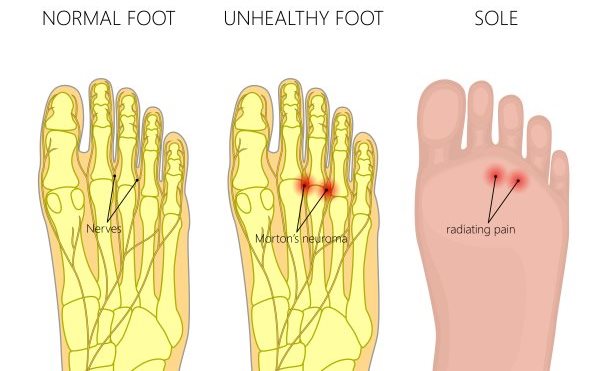Morton’s neuroma is one of the lesser known, yet very painful foot conditions that can afflict a human being. It goes by several other names as well:
- Morton’s neuralgia
- Morton’s metatarsalgia
- Intermetatarsal neuroma
- Plantar neuroma
It is caused by a nerve that becomes thickened and starts becoming painful. It’s a very important nerve, since its task is to provide sensation to the areas in between your toes. It will become a lump if you let it fester. Some people think it is a cancer tumor, but that is not true. It has nothing to do with cancer at all. It’s not lethal, but incredibly painful.
Although there are many risk factors which, combined, set you up for developing this condition. One of the best things you can do is make sure to buy supportive, Morton’s neuroma shoes to make sure that you never even develop a neuroma to begin with. But this is not the end of it. Keep reading to learn more.
What Causes Morton’s Neuroma?
In between your toes, you have a nerve which is called the common plantar digital nerve. This nerve makes it possible for you to have sensations of touch in between your toes’ webspace. The nerve is located close to a very important ligament which gives you support in your forefoot. This transverse intermetatarsal ligament runs across the forefoot’s bones.
The nerve that is affected in Morton’s neuroma, runs right under this essential ligament, which is located in the ball of the foot. It’s pretty much trapped under there. And if it gets to experience too much pressure, too frequently and for too long a time, then it can become chronically irritated, which will cause it to develop fibrosis. It will thicken.
This is what causes the big lump that you see in between the 3rd and 4th toes of a person who suffers from this. And once you’ve got it, you’re pretty close to being caught up in a downward spiral. The thickened nerve will create even more pressure on surrounding tissues, most important of which are yet other nerves. The pain just keeps on getting worse. It can get to a point where you will not even be able to walk anymore.
What Are Morton’s Neuroma’s Symptoms?
The symptoms for this thickened nerve are usually on the outer side of the foot, in between toe number 3 and 4. However, the pain that radiates from the thicked nerve that is located here, can expand all the way up to the rest of your foot. So long as the neuroma is small, you will not really feel much of a lump at all.
However, continual pressure excertion can cause the nerve to swell up even more and become immensely painful. Generally speaking, the pain will be worse when you are wearing shoes and walking. The reason for this is simple: most shoes will constrict your foot to some extent. So when you continue walking like nothing’s the matter and you’ve got yourself a starting neuroma… then you’re setting yourself up for the growth of it.
Keep this up for long enough, and eventually you’ll get the feeling like there is a pebble in your shoe. Since this condition concerns the nerves, i t is also possible that you will feel numbness and tingling in your foot. This condition becomes worse as time goes on and nothing is done to fix the cause. Pain flare ups may come and go multiple times per week. But as the condition becomes worse, the number of pain flare ups will increase. As will their intensity.
It’s possible to develop multiple neuromas in a single foot. This is rare, however.
What Facilitates Morton’s Neuroma?
Morton’s neuroma is a fairly common condition. But women are far more prone to developing it than men are. If you are female, your chances of developing this condition are 4 times higher than if you had been a man.
Another factor that factors in for the development of this painful foot affliction, is your age. If you are over the age of 50, then you also have a higher chance of developing this condition.
Generally speaking, walking is good for you. However, walking will strain your feet, no matter how supportive the shoes are that you are wearing. If you are a person who walks a lot, then this raises your chances of developing Morton’s neuroma a little bit.
It is never a good idea to wear narrow shoes, or shoes with very high heels. Shoes like these do not promote a natural stride and will only help you in excerting the wrong kind of pressure on your own feet, increasing your risk for developing Morton’s neuroma. This is why the treatment for Morton’s neuroma always includes getting roomy, supportive shoes that will take the pressure off of your poor feet.
Next to walking on the wrong kind of shoes, high impact activities such as basketball, running, tennis or other sports, also contribute to a higher risk of developing Morton’s neuroma. Anything that will put too much pressure on your transverse intermetatarsal ligament, will cause too much pressure on your common digital plantar nerve, which in turn leads to a never ending cascade of nerve pain.
[jbio template=”bootbomb0″]


0 comments